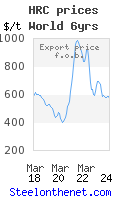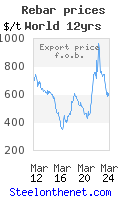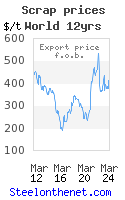Falling Chinese steel exports
So far this year, Chinese crude steel production has been racing upwards and if the 6% growth seen so far continues to the end of the year, the country will have produced more than 851 million tonnes of steel which would be a new record level. Unlike in past years, this growth in output is being channelled into internal infrastructure demand. ISSB have reported earlier in the year that Chinese exports have been falling but this decline has actually been accelerating as the year progressed. The year started with monthly year on year falls of around 25% but September saw a 42% decrease and the October decrease of 36% to 4.9 million tonnes represented the lowest monthly total since February 2014.
The decline has been most evident in long products with exports in the year to date down 59% when compared to last year. The decrease in flat product exports has been much more modest in the same time period, at just under 8%. There was a 41% decrease in shipments to the Middle East , exports to other Asian countries were down 33% and shipments to the EU fell by 35%. Despite this, China Russia increased by 27% and interestingly shipments to the three NAFTA countries increased by 10%, mainly due to elevated levels of steel exported to Canada US
The hike in Chinese steel demand took most of the steel community by surprise this year and although there are currently no signs that the government is reducing its spend on infrastructure, it seems logical to assume that this rate of growth cannot continue indefinitely. Indeed, the World Steel Association is currently forecasting no growth at all next year, with demand predicted to be flat. It could well be that as with this year, this growth figure is on the conservative side but if not, given the sheer volumes involved, it only takes a small percentage decline in demand levels for global markets to be flooded with Chinese steel once again.
You can download a file showing monthly Chinese exports here or alternatively visit ISSB for more information on steel.
Labels: china steel exports, chinese steel, chinese steel demand, Chinese steel exports, ISSB, steel anti-dumping



